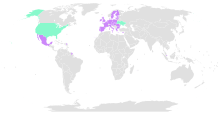Hague Choice of Court Convention
| Convention of 30 June 2005 on Choice of Court Agreements | |
|---|---|
 parties (purple) and signatories (green) | |
| Signed | 30 June 2005[1] |
| Location | The Hague, The Netherlands[1] |
| Effective | 1 October 2015[2] |
| Condition | 2 ratifications/accessions[1] |
| Signatories |
European Union Singapore Ukraine United States[2] |
| Parties | 3 (European Union, Mexico and Singapore)[2] |
| Depositary | Ministry of Foreign Affairs of the Kingdom of the Netherlands |
| Languages | English and French |
The Hague choice of court convention, formally the Convention of 30 June 2005 on Choice of Court Agreements is an international treaty concluded within the Hague Conference on Private International Law. It was concluded in 2005, and entered into force on 1 October 2015. The European Union (covering the European territory of all member states except Denmark), Mexico and Singapore are parties to the convention.[2] Ukraine and the United States signed the convention, but did not ratify.
Parties under the convention recognize a choice of court agreement between parties in the field of civil law and thus courts not chosen in the agreement will stay all proceedings (unless the chosen court refuses to uphold the jurisdiction). For the convention choice of court agreements must be "exclusive": which means in the context of the convention that also a group of courts may be chosen, as long as they are in the same country. It is not required for a choice of court agreement to explicitly state that the agreement is exclusive, designating a specific (set of) courts will automatically render it exclusive.
Judgements by the chosen court must be recognized in all states where the convention is applicable.
History
The Hague Conference started with the "Judgements project" in 1996: the development of a convention regarding jurisdiction and recognition of judgements. Jurisdiction within such a convention would be classified in three categories: bases of jurisdiction which were obligatory, optional or prohibited. As the negotiators were not able to come to a consensus on such a convention, the scope of the work was reduced to jurisdiction and recognition of decisions based on a choice of court agreement between the parties. During the negotiations parallels were drawn between the New York Convention on arbitral awards: the aim was to create a system of recognition of decisions based on court cases where the court was chosen pursuant to a choice of court agreements, which would create the same level of predictability and enforceability as is the case in arbitral awards in New York Convention states.[3]
Parties
| State | Signature | Ratification/Accession | Entry into Force | Comments |
|---|---|---|---|---|
| | 1 April 2009 | 11 June 2015 | 1 October 2015 | EU territory of all member states except Denmark; does not apply to certain insurance contracts |
| | 26 September 2007 | 1 October 2015 | ||
| | 25 March 2015 | 2 June 2016 | 1 October 2016 | |
| | 21 March 2016 | |||
| | 19 January 2009 | [4] |
References
- 1 2 3 text of the treaty
- 1 2 3 4 "Status Table: 37: Convention of 30 June 2005 on Choice of Court Agreements". HCCH. Retrieved 19 April 2013.
- ↑ Ronald A. Brand and Paul M. Herrup. The 2005 Hague Convention on Choice of Court Agreements. Cambridge.
- ↑ https://www.hcch.net/en/instruments/conventions/status-table/?cid=98